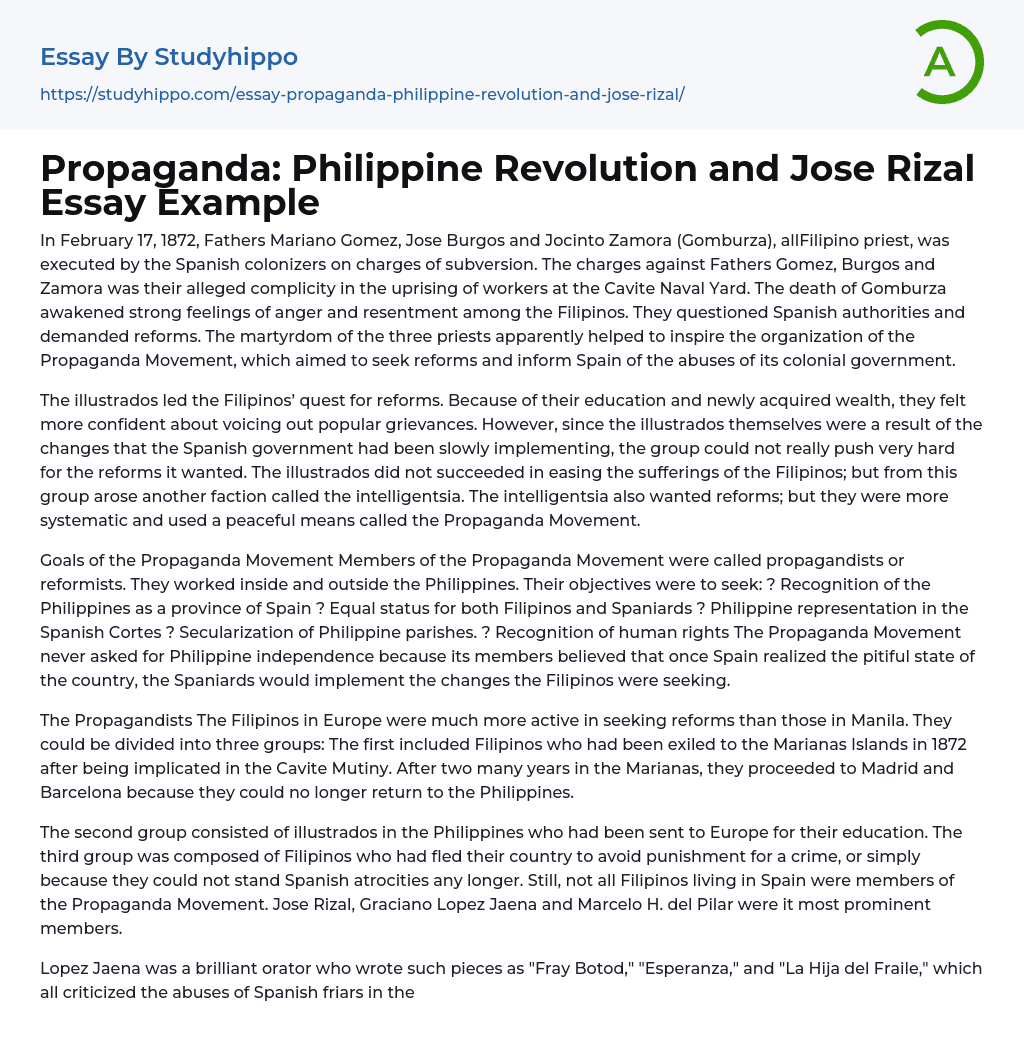In February 17, 1872, Fathers Mariano Gomez, Jose Burgos and Jocinto Zamora (Gomburza), who were Filipino priests, were executed by the Spanish colonizers for subversion. They were accused of being involved in the uprising of workers at the Cavite Naval Yard. The execution of Gomburza sparked anger and resentment among the Filipinos, leading them to question Spanish authorities and demand reforms. This event also played a role in inspiring the formation of the Propaganda Movement, which aimed to seek reforms and inform Spain about the abuses of its colonial government.
The Filipinos' pursuit of reforms was led by the illustrados, who felt empowered to express popular grievances due to their education and newfound wealth. However, as the illustrados themselves were a product of the gradual changes implemented by the Spanish government, they faced limitations in advocating for the reforms they desired. Although they were unable
...to alleviate the suffering of the Filipinos, their efforts gave rise to another faction known as the intelligentsia. The intelligentsia also sought reforms but adopted a more orderly approach through the peaceful Propaganda Movement.
The Propaganda Movement, also known as reformists, had multiple objectives within and outside the Philippines. These objectives encompassed gaining recognition for the Philippines as a province of Spain, attaining equal status for Filipinos and Spaniards, securing Philippine representation in the Spanish Cortes, advocating for the secularization of Philippine parishes, and obtaining acknowledgment of human rights. It is crucial to acknowledge that the Propaganda Movement did not explicitly call for Philippine independence. Instead, its members believed that by making Spain aware of the dire situation in their country, they would prompt Spain to implement the reforms advocated by Filipinos.
Th
Filipinos in Europe were more active in seeking reforms compared to those in Manila. They can be categorized into three groups - the first group consisted of Filipinos who were exiled to the Marianas Islands in 1872 due to their involvement in the Cavite Mutiny. After spending many years in the Marianas, they relocated to Madrid and Barcelona since they were unable to return to the Philippines.
The second group in the Philippines consisted of illustrados who were sent to Europe for their education. The third group included Filipinos who fled their country to escape punishment or due to Spanish atrocities. However, not all Filipinos living in Spain were part of the Propaganda Movement. Its most prominent members were Jose Rizal, Graciano Lopez Jaena, and Marcelo H. del Pilar.
Lopez Jaena, a brilliant orator, wrote pieces such as "Fray Botod," "Esperanza," and "La Hija del Fraile," all of which criticized the abuses of Spanish friars in the Philippines. Del Pilar, an excellent writer and speaker, established the newspaper Diarion Tagalog in 1882, focusing on the friars as his favorite topic. Some of his most popular writings were "Caiingat Cayo," "Dasalan at Tocsohan," and "Ang Sampung Kautusan ng mga Prayle." "Caiingat Cayo" responded to criticisms of Jose Rizal’s novel Noli Me Tangere in pamphlet form. "Dasalan…" parodied the prayer books used by the Church, while "Ang Sampung Kautusan…" satirically depicted the Ten Commandments and strongly ridiculed the Spanish friars.
Jose Rizal, renowned as the great novelist of the Propaganda Movement, was the first Filipino to gain fame for his written works. Even at the tender age of eight, he showcased his talent by composing the poem "Sa Aking mga
Kababata." His novels, Noli Me Tangere and El Filibusterismo, vividly portrayed the hardships endured by the Filipino people and shed light on the rampant injustices committed by the friars during their colonial rule. Unsurprisingly, Rizal's critical view of the government and the friars earned him numerous adversaries. Ultimately, on December 30, 1896, Rizal met his demise at Bagumbayan (later known as Luneta Park and now renamed Rizal Park) through execution.
The writings produced by the Propaganda Movement served as inspiration for Andres Bonifacio and other radicals in establishing the Katipunan, thus catalyzing the Philippine Revolution. Additionally, they continued to have an impact on La Solidaridad and La Liga Filipina.
- Barangay essays
- Caste System essays
- Citizenship essays
- Civil Society essays
- Community essays
- Culture essays
- Deviance essays
- Discourse Community essays
- Female essays
- Filipino People essays
- Igbo People essays
- Indigenous Australians essays
- Indigenous Peoples essays
- Men essays
- Middle Class essays
- Minority Group essays
- Modern Society essays
- Popularity essays
- Social Control essays
- Social Institution essays
- Social Justice essays
- Social Norms essays
- Social Responsibility essays
- Socialization essays
- The nation essays
- American Civil War essays
- Atomic Bomb essays
- Attack essays
- Cold War essays
- Crimean War essays
- Diplomacy essays
- Emilio Aguinaldo essays
- Emperor essays
- Hitler essays
- Iraq War essays
- Korean War essays
- Mexican American War essays
- Nazism essays
- Nuclear Weapon essays
- Philippine Revolution essays
- Revolutionary War essays
- Rwanda essays
- The Spanish American War essays
- Trench Warfare essays
- Tribe essays
- Vietnam War essays
- War of 1812 essays
- Western Front essays
- World War I essays
- World War Ii essays




